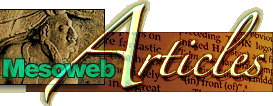

| The protective roof over the masks had burned off in this photograph from February 2001, an unfortunate event in the recent history of Acanceh. Photo: Joel Skidmore. |

![]()
![]()
|
The site of Acanceh has never really been lost, as it has been uninterruptedly occupied since the Preclassic (from around 300 B.C. onwards) until the present. This site is unique in its integration of the modern town and the remains of its ancient past. For example, next to the main pyramid there is a grocery store, a bakery, several lots and even an Alcoholics Anonymous meeting place. The Palace of the Stuccos is surrounded by private property where washing lines are not an uncommon sight. A striking recent discovery is the fact that Acanceh seems to have always been the name of this place, as proven by an ancient hieroglyphic text found in the town and only recently read by epigraphers. The meaning of this name is usually glossed as "Lament of the Deer".
The first mention of Acanceh from an archaeological perspective was made by the French explorer-photographer Desiré Charnay, who spoke of structures built with finely-carved blocks not unlike other Maya buildings of the area. The first archaeological work to have ever taken place at this old town was done by another explorer-photographer: the Austrian Teobert Maler, who reported a mound of loose stone in the town's main square, underneath which he found remains of a once-vaulted chamber as well as stucco masks. Nevertheless, Maler did not consolidate the building. It is important to mention that Maler also photographed the unusual and fascinating stucco reliefs for which the Palace of the Stuccos, the second major structure in Acanceh, is named. By 1933, when Mexican scholar Miguel Angel Fernández worked at the site, he noted that the decoration reported by Maler was all but gone. Nevertheless, through the use of what remained and Maler's photographs, he was able to draw a reconstruction of the building prior to consolidating it. It turned out that the building was of a typical early (Late Preclassic to Early Classic) Petén configuration known as a radial pyramid: one that is basically square and has staircases oriented towards all four cardinal directions. The loose stone reported by Maler, however, points to the fact that there once was a later construction covering the early building visitors see today. Very recently, Acanceh was the focus of a major archaeological effort, conducted by Beatriz Quintal. Quintal's project uncovered a great deal of the hitherto unexcavated Palace of the Stuccos, brought to light a previously ignored but substantial pyramidal building in the town and found four spectacular giant stucco masks on the main temple's eastern, western and northern façades. Judging from the style of the large masks, the building may have well been built in the Late Preclassic, marking Acanceh as an important urban center as early as some 2,000 years ago. Quintal's project also included a general survey of the ancient town, which determined the existence of a minimum of 160 structures spread over an area of more than two square kilometers.
|